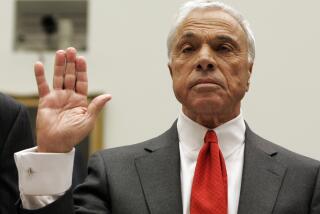Crash Dims Popularity of Bridge Loans : Investment Banks Will Be Far More Cautious
- Share via
NEW YORK — The stock market crash of Oct. 19 and its aftermath threaten to put a kink in one of Wall Street’s most popular financing gimmicks for mergers and acquisitions: the “bridge loans” through which top investment firms committed their own money to help close important deals.
Investment professionals involved in such deals, which came under the category of “merchant banking,” say that their firms are likely to be much more reluctant in the future to provide such risky loans with fees and interest rates as low as those of the past.
Furthermore, the firms will subject the underlying deals to more rigorous credit analysis than was the rule before mid-October. And the percentage of an acquisition price to be financed through loans and public debt offering will probably fall, as lenders come to insist that deals be backed by more equity.
In the meantime, however, leading investment banks have more than $1.5 billion in capital on loan as bridge financing. The firms had expected to recover this money quickly by floating junk bonds to provide permanent financing for the underlying takeover or buyout deals.
But since the crash, the market for all but the least speculative variety of junk bond has significantly contracted; the difficulty of floating junk bonds has left many firms with loans on which they are collecting interest but at rates well below what they consider adequate to cover their risk.
Improved Risk Assessment
For not only have interest rates risen throughout the lending market, but the crash has increased the possibility of a recession--which could damage the financial health of many companies that have been subjected to buyouts or takeover.
“There’s some feeling that what looked like a high profit (on a bridge loan) pre-Oct. 19, doesn’t look that way now,” said Donald Gogel, a merchant-banking executive at Kidder, Peabody & Co.
Wall Street professionals say no single firm has so much money invested in bridge loans that its health is jeopardized. Several firms refinanced their outstanding bridge loans in the junk-bond market in September and pre-crash October. But problems with some ongoing deals indicate that the risk of such financings is much greater than their proponents had acknowledged.
“The approach to merchant banking and bridge loans will have to be re-thought,” said Lawrence Eckenfelder, a brokerage industry analyst for Prudential-Bache Securities. “The assessment of risk will improve.”
The most serious failure of a bridge-financed deal is that of Southland Corp. The top executives of Southland, which owns the 7-Eleven convenience store chain, got a $600-million bridge loan from Salomon Bros. and Goldman Sachs this summer to help finance their $4.9-billion buyout of the company. The company’s plan was to float $1.5 billion in junk bonds at interest rates of 15% to 17% to refinance the bridge loans and other funding.
Big Deals Jeopardized
This week, however, Southland said there was considerable doubt over whether the junk bonds could be sold at those prices. Among other problems, according to professionals familiar with the markets, the financial chaos of the last month has lifted the rates demanded for even relatively secure junk bonds to 15% to 16%--meaning that riskier bonds like Southland’s would require an even higher interest rate.
The snag means Salomon, Goldman, and their investment partners are left with loans to Southland paying a reported prime rate-plus-five points, or in today’s market 13.75%--a below-market rate for a loan so risky.
Other deals are being subjected to new demands by lenders.
“This is a very monopolistic business,” said Asher Edelman, a takeover entrepreneur who has been offered about $600 million in bridge financing by Shearson Lehman Bros. for a takeover of Telex Corp. “There are only a few firms in a position to do bridge loans. These few people might decide to insist on new things.” Edelman said the future of the Telex deal revolves not around the availability of the loan but is “more a question of what kind of (financial) structure is involved.”
Salomon, Goldman, Kidder and other leading firms began making bridge loans about a year ago as an indispensable element of what they termed “merchant banking”--a maneuver in which the firms became direct participants in acquisitions and takeovers, rather than simply arranging the transactions for clients. The rationale was that the money to be made as part-owners of the resulting enterprises was much greater than the fees that they could collect for their advice.
In the euphoric financing days before the crash, the terms for bridge loans had become almost standardized: The lender got 1% of the loan’s value for its commitment to do the financing, 1% for the funding itself, and the prime rate plus five percentage points in interest on the loan.
Now, Kidder Peabody’s Gogel said, the prices of such loans are likely to reflect the riskiness of the individual deal. “You’ll see a differentiation of bridge-loan pricing that reflects the underlying credit, because clearly not every loan has the same risk-reward profile.”
More to Read
Inside the business of entertainment
The Wide Shot brings you news, analysis and insights on everything from streaming wars to production — and what it all means for the future.
You may occasionally receive promotional content from the Los Angeles Times.










